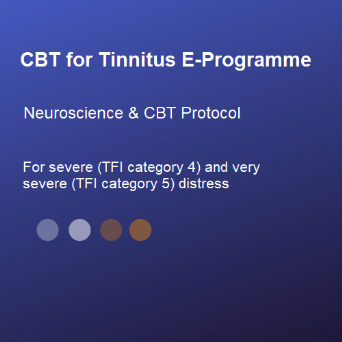The Tinnitus E-Programme was first made available in 2009. Originally, it provided the content I used in my NHS Tinnitus Management clinics and was made available in six modules to be used over a period of 6-10 weeks. It was entirely Self-Directed. In 2018, it became therapist supported and later in the year, was moved to a purpose-built learning platform CourseCraft and in 2022, to a different platform called Podia.
The CBT for Tinnitus E-Programme comprises 12 stages. Enrolment includes a choice of one, two or three 1-1 appointments using Zoom
The Tinnitus Functional Index (TFI) is the main indicator for the number of 1-1 appointments to choose:
- 0 – 17% = Tinnitus is not a problem (Category 1)
- 18–31% = Tinnitus is a small problem (Category 2)
- 32-53% = Tinnitus is a moderate problem (Category 3)*
- 54-72% = Tinnitus is a big problem (Category 4)**
- 73-100% = Tinnitus is a very big problem (Category 5)***
*1 x one-to-one appointment is recommended to be included
** 2 x one-to-one appointments recommended
*** 2 or 3 one-to-one appointments recommended
Complete a Tinnitus Functional Index (TFI) to find out your score
Why Choose Online Working?
- Work at your own pace at times that suit you rather than having to attend pre-booked attendances
- Cost: by far the most common reason. Because there is less therapist time one to one, cost is greatly reduced
- Effectiveness: the research has evidenced that Outcomes through working online are as good as those through one to one Go to evidence
CBT for Tinnitus E-Programme
The programme follows a Neuroscience & CBT protocol. The modules lead you through the process, opening week by week. The physiology and neurobiology that cause the symptoms we experience as distress are explained, alongside understanding the mechanism of tinnitus. They are intrinsically linked in the neural pathways and patterns (neurons firing throughout the brain).
It is because of how we feel about tinnitus that it causes distress. If we feel nothing for and about the noise we experience as tinnitus, we'd not react to it. In fact, we'd not bother to tune in and listen to it. It would be much the same as being used to traffic going about its business outside the house. You know it's there but so what? Most of us habituate to traffic noise and other sensory information in our environments. Think about the last time you were in a supermarket. Was there music playing? What noises did you NOTICE while you were in there? The likelihood is you don't remember, and another likelihood is that while you were there, you didn't think about it. In the course, you'll learn about our 3 levels of hearing, "Significance of Sound", and the impact of "meaning" i.e. what a sound might mean to us.
These are all factors that are monitored subconsciously and when there is no significance and no meaning - positive or negative - the conscious part of us doesn't have to consider it. It is when there IS significance and meaning that our attention is drawn and we become conscious of what is happening. Being brain-based, this means that the pre-frontal cortex (PFC) has to make a decision - "how do I feel about this?" "I don't like it" so monitoring of the situation takes over - a joint effort by both the subconscious (limbic system) and conscious (PFC).
What makes us feel one way or another depends on the perspective we bring to a situation - 'not care about', 'care about and like', 'care about and dislike'? Are we immersed in a PROBLEM-ORIENTED perspective, or a RECOVERY-ORIENTED perspective? We feel what we do because of the meaning we attach to each given situation. Those meanings become BELIEFS. They come from subconscious 'filters' based on previous experience. Many of these filters have been there since childhood, but we are always adding, strengthening and changing filters. We only tend to weaken filters through being conscious of them. We can only change them by first becoming consciously aware of them, allowing the PFC to moderate them to bring about a filter-change in the subconscious.
The 'filters' are called Cognitive Distortions: distorted understanding that gives rise to a distorted meaning/significance. There are more than a dozen of the most common Cognitive Distortions, but as individuals, we have a tendency to use the same 3 or 4 of them over and over. Probably the most common are "Predicting the Future", "All or Nothing Thinking" (black and white thinking), "Maximising the Negative while Minimising the Positive" and "Emotional Reasoning".
Over my 30 year career for example, guess how often I have heard people say things like: "I'll never feel normal again"; "Tinnitus has ruined my life"; "No one knows how bad this is"? Those statements are true for the person saying them - they BELIEVE them to be true. And BELIEFS are powerful.
But what happens once those same people understand what BELIEFS are? That they come through "filters" from the subconscious....? In most cases, they recognise their Cognitive Distortions immediately.
TFI repeated
Around week 7-9, the measures used at the start (including the TFI) are repeated, and they are repeated again towards the end of the process. This is how progress is measured. You'll find feedback from users of the CBT for Tinnitus E-Programme - including their TFIs - in reviews. Published Outcomes are also available.
